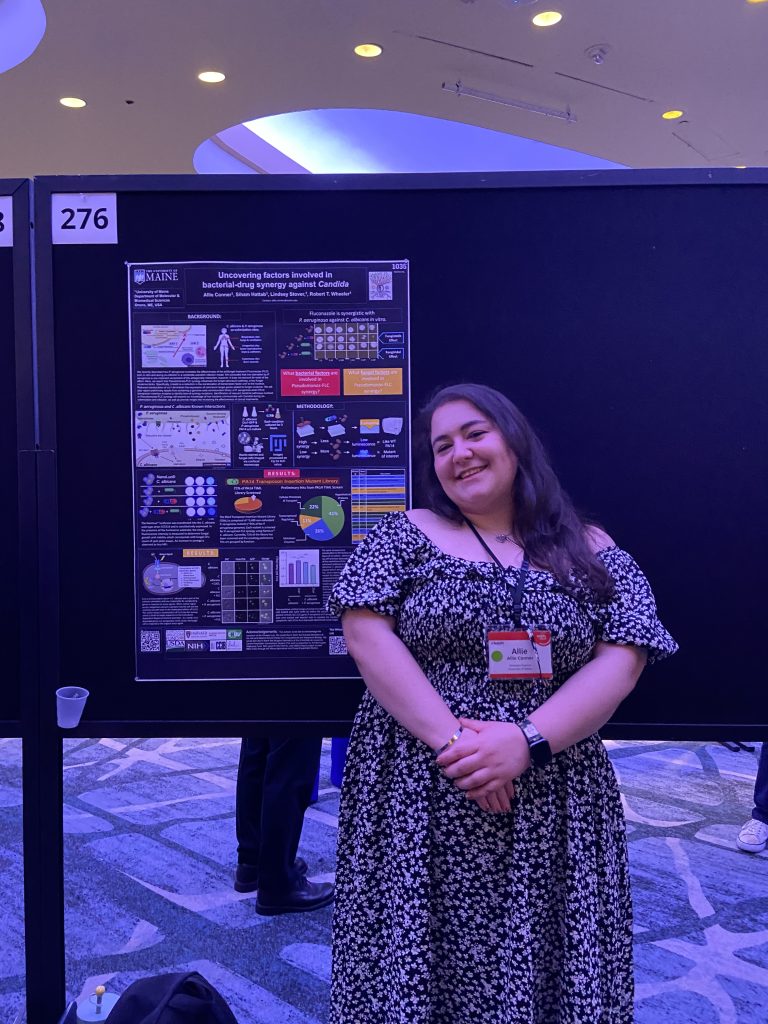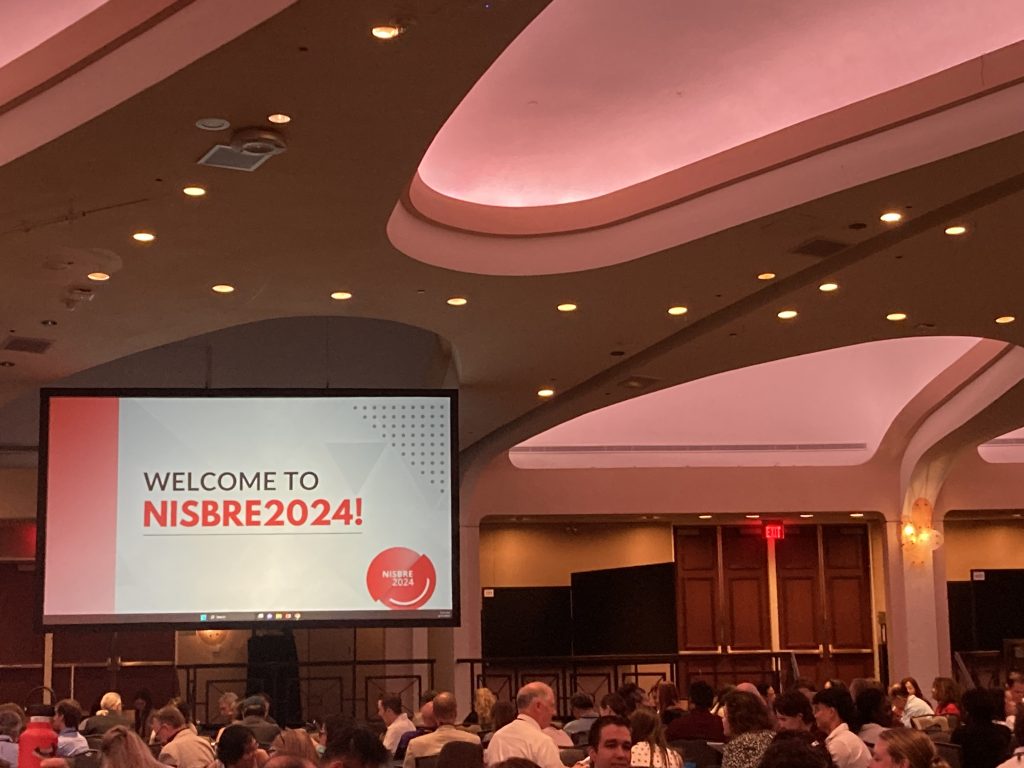
COBRE project leaders and students present at the NISBRE conference
The National IDeA Symposium of Biomedical Research Excellence (NISBRE) conference was held June 16-19 in Washington DC.
Clarissa Henry, director for the UMaine Center of Biomedical Research Excellence (COBRE), project leaders Ben King, Jared Talbot, Romain Madeleine, and MIAC core director Robert Wheeler attended the conference. The event featured closed meetings for IDeA COBRE, INBRE, CTR, I-RED Program Directors (NAIPI), keynote addresses including a presentation by John Lorsch, Director, National Institute of General Medical Sciences, National Institutes of Health, science presentations, poster sessions and workshops.
Clarissa Henry was a panelist in a Grant Writing Workshop: Training Mechanisms. Jared Talbot gave an oral presentation called Fast-twitch myofibrils grow in proportion with Mylpf dosage. He won a Research Merit Award for this project, which was delivered during a ceremony at the end of the conference. Ben King also gave a flash talk, Inhibition of NADPH Oxidase 2 Improves Survival in Zebrafish Infected with Influenza A Virus and was a panelist on the Leveraging the NIGMS Sandbox to Advance Biomedical Research Using Cloud Computing session. Robert Wheeler, director for the Microscopy core, presented a poster on Establishment of Super-resolution Confocal Microscopy CORE.
Two UMaine graduate students participated in the conference. PhD student Sophie Craig, attended on behalf of her mentor Melissa Maginnis, one of the COBRE project leaders unable to attend and presented a poster on JC polyomavirus entry and signaling in primary cells, co authored with Melissa Maginnis. Allie Conner, a PhD student in the Wheeler lab received a travel award from Graduate Student Government to attend the conference where she presented a poster on Uncovering Factors Involved in Bacterial-Drug Synergy Against Candida.
The Maine research community was well represented at the event, a wonderful opportunity to network and socialize with other Maine COBRE recipients including GSBSE students from UNE, MaineHealth and MDIBL. Coordinators and faculty from INBRE Institutions, UMaine, Colby and Bowdoin also attended.
Cecile Ferguson, program manager for the UMaine COBRE grant, learned a lot from workshops with NIH program officers, heard more acronyms in two days than in the past year and met in person with the COPA group, a supportive network of New England COBRE program administrators. Never COBRE alone!
Established by Congressional mandate in 1993, the Institutional Development Award (IDeA) program’s goal is to broaden the geographic distribution of NIH funding. It supports faculty development and institutional research infrastructure enhancement in states that have historically received low levels of support from NIH. In addition to enhancing the competitiveness of investigators and the research capacities of institutions in these 23 states plus Puerto Rico, the program serves their unique populations, such as rural and medically underserved communities.
UMaine NISBRE presentations, talks and posters
Clarissa Henry, Professor, University of Maine
Panelist, Grant Writing Workshop: Training Mechanisms
A two-hour session with experienced NIH reviewers. Experts talk about the review process, give their advice about what are often overlooked sections of an application, and provide general tips for proposal success. They will teach about finding relevant grant mechanisms and program announcements and gain insight into the grant review and resubmission processes from the reviewer lens. Bring your questions and join in this exciting session!
Benjamin King, Associate Professor of Bioinformatics, University of Maine
Flash talk, Infectious Diseases session
University of Maine. Inhibition of NADPH Oxidase 2 Improves Survival in Zebrafish Infected with Influenza A Virus. Co-Authors: Brandy-Lee Soos, Alec Ballinger, Mykayla Weinstein, Julianna Grampone. Co-Authors Institutional Affiliations: University of Maine.
Benjamin King, Associate Professor of Bioinformatics, University of Maine
Panelist, Leveraging the NIGMS Sandbox to Advance Biomedical Research Using Cloud Computing
Learn more about the NIGMS Sandbox, a cloud-based learning platform that provides educational modules focused on various topics in the biomedical sciences. Hear from investigators who have used the NIGMS Sandbox to extend their research using cloud-based computing. We invite you to attend this session and learn ways cloud computing can transform your research, enhance your team’s data analytic capabilities, and increase future data storage and sharing opportunities.
Jared Talbot, Assistant Professor of Developmental Biology, University of Maine
Flash Talk, Genetics and Genomics Session
Scientific short research presentations (15 minutes) and flash talk
Scientific Presentation Awards
Scientific Presentation Awards were selected by the session co-chairs and reviewed by the Organizing Committee based on abstracts submitted. All flash talk and short research presentation abstracts were considered for Scientific Presentation awards.
Poster Presentations
Robert T Wheeler, University of Maine.
Establishment of Super-resolution Confocal Microscopy CORE.
One of the crucial technological needs for the University of Maine COBRE is high-quality confocal fluorescence microscopy and image analysis. Our investigators have diverse technological requirements, from moderate super-resolution to high-speed live cell imaging. To provide this service for the COBRE, we worked closely with the COBRE investigators to choose the best microscope system and image analysis software for them. We have acquired this equipment and set it up within the first year of the grant, and have successfully trained several individual microscopists in each investigator’s laboratory.
This required navigating a number of obstacles, including purchasing constraints and difficulties in hiring a full-time microscopist. We have successfully vaulted these hurdles and have also received funding for capital improvements to the imaging suite that will improve the imaging and processing experience.
Here, we will describe our experiences and discuss how it is important to work closely with the COBRE investigators to successfully navigate difficulties and develop a core facility that enhances the capabilities of the investigators.
Allie Conner, University of Maine.
Uncovering Factors Involved in Bacterial-Drug Synergy Against Candida. Co-Authors: Siham Hattab, Lindsey Stover, Robert Wheeler. Co-Authors Institutional Affiliations: University of Maine. COBRE
The yeast, Candida albicans, and the bacterium, Pseudomonas aeruginosa, are opportunistic pathogens that co-colonize multiple sites within the human host, particularly in the immunocompromised lungs of Cystic Fibrosis (CF) and mechanically ventilated patients. CF patients co-colonized with both C. albicans and P. aeruginosa experience reduced lung function and poorer prognosis. We recently described how P. aeruginosa increases the effectiveness of the antifungal treatment Fluconazole (FLC) both in vitro and during co-infection in a vertebrate zebrafish infection model. We concluded that iron starvation by P. aeruginosa is one important component of this antagonistic interaction; however, it does not account for most of the effect. Here, we report that Pseudomonas-FLC synergy influences the fungal calcineurin pathway, a key fungal virulence factor. Specifically, it leads to a reduction in the translocation of transcription factor crz1 to the nucleus. Reduced translocation of crz1 diminishes the expression of calcineurin target genes related to fungal virulence. We will also report preliminary results from screening a genome-wide nonredundant library of P. aeruginosa strain PA14 transposon insertion mutants to identify loss-of-synergy mutations. Identification of relevant bacterial pathways involved in Pseudomonas-FLC synergy will expand our knowledge of how bacteria communicate with Candida during co-colonization and infection, as well as provide insight into increasing the effectiveness of clinical treatments.
Sophie E. Craig, University of Maine.
Uncovering mechanisms of JC polyomavirus entry and signaling in primary cells. Co-Authors: Gabriella Giftos, Michael P. Wilczek, Melissa S. Maginnis. Co-Authors Institutional Affiliations: University of Maine. COBRE
JC polyomavirus (JCPyV) infects 50-80% of the human population worldwide, establishing a lifelong, asymptomatic infection in the kidney. Under immunosuppressive conditions, the virus can spread to th ebrain and infect the glial cells. This results in a demyelinating neurodegenerative disease called progressive multifocal leukoencephalopathy (PML). PML is debilitating, with symptoms including motor dysfunction and cognitive impairment, and has no cure or approved treatment. Research to understand the JCPyV infectious cycle is necessary to develop antivirals. Most JCPyV research has been performed in immortalized cell lines, which has led to important advancements. However, immortalized cells are not the most accurate model for infection, and this work has not revealed the cell type-specific JCPyV infectious mechanisms that account for JCPyV pathogenesis in the kidney and brain. Primary cells better
represent the phenotype of infected cells in vivo. Differences in signaling pathway activation during infection of immortalized and primary brain cells suggest cell type-specific JCPyV mechanisms of entry and infection. Thus, mechanisms of JCPyV infection must be characterized in primary cells. Using inhibitors, siRNA knockdown, and infection assays, we have begun to elucidate the mechanisms of viral entry and signaling pathway regulation in primary kidney and brain cells. My research suggests that JCPyV infection occurs by clathrin-mediated endocytosis in primary cells, and my future research will investigate cell type-specific signaling mechanisms during infection. This work illuminates JC polyomavirus infection mechanisms in primary cells, helping to uncover potential targets for antivirals
that could reduce the spread of JCPyV and the impact of PML.








